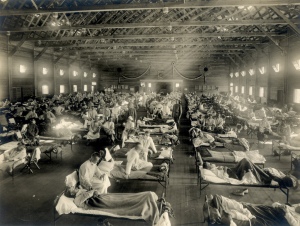Monthly Archives: November 2014
The Materiality of Virus: The Aesthetics of Ebola

Flu patients being treated at Camp Funston, Kansas during the 1918 epidemic (image National Museum of Health and Medicine).
In 1918 over 500 million people were infected by the influenza virus, and its lethality–between 20 and 100 million people died—reaches well beyond AIDS, the Plague, and even the Great War itself. It is not difficult to comprehend the terror induced by viral disease: we live in a historical moment in which some infectious disease can be rapidly spread aboard airlines and cruise ships; the media and a host of online outlets fan anxieties about epidemic diseases; and popular culture delivers warnings about apocalypse, zombies, and doomsday preparations. In contrast to the European battlefield in 1918, it was enormously difficult to imagine the material form and aesthetics of a virus that moved invisibly and left as its material wake broken and dead bodies. Viruses are terrifying because they are so hard to imagine as concrete things, so we spend much of our energy imagining how we can perceive and protect ourselves against an unseen specter. Read the rest of this entry
Beautiful Absence: The Aesthetics of Dark Heritage
The former Czech village of Lidice is today a peaceful countryside, a neatly cropped rolling field punctuated by a postcard-cute babbling brook and a scatter of trees. The massive lawn rolls over some nearly imperceptible depressions and a couple of neatly landscaped foundations, but only a few benches and sidewalks disrupt the bucolic landscape. Nestled in a modest rural setting seemingly far from nearby Prague, the space is a quiet and even peaceful place of reflection that is far-removed from its quite unpleasant heritage.
Like many dark heritage sites, the horrific narrative of mass murders and the complete razing of Lidice in 1942 contrast with an aesthetically pleasant contemporary space. Lidice perhaps magnifies the role of imagination because it has exceptionally sparse material remains in the midst of a pleasant countryside; nevertheless,the imaginative experience of comprehending inexpressible barbarism in the midst of settled contemporary landscapes is common to many dark heritage sites. Lidice illuminates the ways contemporary landscape aesthetics and material absences profoundly shape dark heritage experiences. Read the rest of this entry


